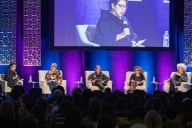You have /5 articles left.
Sign up for a free account or log in.

Getty Images
You can’t argue with hard data about gender bias in science. Except that lots of people do, especially men in online comments about research on the topic. That’s the major finding of a study published today in Psychology of Women Quarterly – that men are much more likely than women to reject findings of sexism in science, technology, engineering and math (STEM), and even to make sexist comments in response to such research.
At the same time, commenters over all are more likely than not to agree that gender bias exists.
While the study is relatively small, with significant limitations noted by authors, it’s already generating buzz for its focus not simply on the well-documented prevalence of gender bias in STEM. Rather, the paper explores how men and women – including scientists – perceive data about bias, and what that might mean for larger efforts at diversifying and supporting women in STEM.
“[M]any current STEM diversity initiatives rest on the theory that exposing participants to evidence of gender bias will ultimately reduce bias and enhance diversity,” reads the paper, titled “Can Evidence Impact Attitudes? Public Reactions to Evidence of Gender Bias in STEM Fields.” However, it says, “If clearly demonstrating bias is just as likely to spark reactive justifications as thoughtful analysis, this approach may not be a reliable prejudice-reduction tool.”
Corinne A. Moss-Racusin, assistant professor of psychology at Skidmore College, led the study with the help of two students, Aneta Molenda and Charlotte Cramer. They analyzed reader comments on popular news stories about a high-profile, relatively straightforward paper by Moss-Racusin published in the Proceedings of the National Academy of Sciences in 2012. That study found that both male and female scientists were more likely to want to hire as a lab manager and award higher pay to a hypothetical student candidate named “John” than one named “Jennifer,” even though the rest of their applications were identical.
The 2012 paper received lots of media attention, but Moss-Racusin for her most recent study focused on comments on articles in The New York Times, the Discover Magazine science blog, the IFLScience website, and on Facebook. An initial analysis revealed that comments didn’t vary widely across websites, so Moss-Racusin collapsed the comments into one data set to perform thematic and quantitative analyses.
After weeding out one-word comments or comments whose meanings were unclear, Moss-Racusin and her team began to code 831 comments both for response type – such as whether they were in agreement with the finding, or sexist, or justified sexism by saying, for example, that women’s careers suffer for biological reasons, such as pregnancy – and, where possible, gender of the commenter. The researchers also looked at whether or not the commenter worked in STEM. Moss-Racusin used a conservative method, choosing not to code gender-inconclusive names such as “Alex” or “Corey.” Responses were also coded separately from names, to avoid interpretation bias.
In the end, about half of the names were coded for gender, with a slightly higher percentage of women commenting than men. Over all, 67 percent of comments acknowledged the existence of bias in STEM or showed gratitude for the study, but only 29 percent of the comments from those who were identified as men affirmed the existence of bias. All of the gratitude comments came from women, where gender could be determined. About 10 percent of the comments over all argued that sexism does not exist, and 68 percent of those comments came from men in the gender-coded sample.
Twenty-percent of all the comments justified the existence of gender bias, such this one: “In nearly all the labs I’ve worked, the people who spent the most nights and weekends in the lab were invariably men. I’ve never actually seen a female set up a cot to sleep in the lab while working on experiments.” Of these kinds of comments, some 80 percent were made by men.
About 8 percent of comments argued that sexism targets men more than women, such as one comment that women have benefited from “every affirmative action,” with 65 percent made by men.
Less than 1 percent of commenters said that the article had changed their mind about sexism in STEM; about 67 percent of these comments came from men. Some 11 percent of comments called for social change, about 46 percent of which were posted by men.
The study also looked at sexist remarks. Some 7 percent of all comments included an instance of sexism, such as “with a few exceptions, the women I worked with were NOT competent, by comparison with men,” or “For an equally skilled man or woman, I would prefer the woman.” Some 77 percent of sexist comments disparaged women, and 23 disparaged men. Of the sexist remarks made against women, 95 percent were made by men. Of the sexist remarks made against men, 50 percent were made by men.
About one-fifth of the sample size could be determined to work in STEM, and their responses did not differ significantly from the sample at large.
Moss-Racusin in an interview said she wasn’t shocked that there was some difference among men and women in their interpretation of the data. But she said she was surprised “by the real scope of different kinds of reactions that people could have” to the exact same evidence, she said.
The complexity of reactions points to why progress in increasing the number of women in STEM fields may be slow, she said.
“This sort of evidence [of gender bias in STEM] can only really lead to progress to the extent that it’s accepted by the scientific community,” she said. “If we’re experientially demonstrating biases but the relevant communities are sort of not accepting it, it will not have the kind of impact we want it to have.”
Moss-Racusin said current interventions – namely educational efforts focused on diagnosing and describing the problem of gender bias in STEM – might be missing a “critical piece” of the puzzle. She advocated more practice-driven strategies, and recommended more research about how gender bias is perceived among the scientific community in particular, beyond comments on the internet. But she said the data set was a strong, “naturalistic” one with which to begin this work.
Christianne Corbett, a senior researcher at the American Association of University Women, said she was initially skeptical about a study based on internet comments – which may be more likely to be made by people who either strongly agree or strongly disagree with the data presented. But she said she was impressed with the study’s methodology and acknowledgement of its limitations. She was particularly impressed with the study’s calling into question predominant strategies for diversifying STEM, she added – namely straightforward education.
Corbett said practice-driven and personalized interventions, such as Project Implicit at Harvard University, in which participants can test their own various biases, and Google’s Unconcious Bias @ Work workshop, can have more impact than data-driven awareness campaigns alone.
"That’s really the frontier of where this research is at,” Corbett said. “Everyone’s trying to figure out what to do. It’s pretty clear now that there’s bias, but what you need to do to change that bias is less straightforward.”









